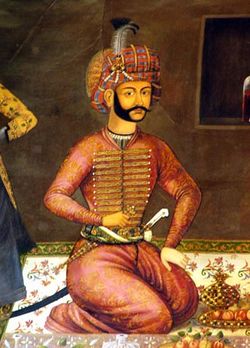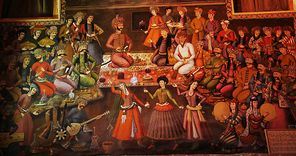عباس الثاني الصفوي
| الشاه عباس الثاني | |
|---|---|
| شاهنشاه فارس، صاحب قيران، سلطان السلاطين | |
 الشاه عباس الثاني | |
| العهد | 15 مايو 1642 – 26 أكتوبر 1666 |
| تتويج | 15 مايو 1642 |
| سبقه | صفي الأول |
| تبعه | سليمان الأول |
| وُلِد | 31 ديسمبر 1632 قزوين |
| توفي | 25–26 أكتوبر 1666 خسروآباد، بالقرب من دمغان |
| المدفن | |
| البيت | الأسرة الصفوية |
| الأب | صفي الأول |
| الأم | أنا خانم |
السلطان محمد مرزا (31 ديسمبر 1632[1] – 25/26 أكتوبر 1666) اشتهر بإسمه الملكي الشاه عباس الثاني (فارسية: شاه عباس دوم) كان شاه فارس من 1642 حتى 1666. وكان سابع شاهات الأسرة الصفوية.
. . . . . . . . . . . . . . . . . . . . . . . . . . . . . . . . . . . . . . . . . . . . . . . . . . . . . . . . . . . . . . . . . . . . . . . . . . . . . . . . . . . . . . . . . . . . . . . . . . . . . . . . . . . . . . . . . . . . . . . . . . . . . . . . . . . . . . . . . . . . . . . . . . . . . . . . . . . . . . . . . . . . . . . .
النشأة
وُلِد عباس الثاني في قزوين بإسم سلطان محمد مرزا.[2][3] He was the son of Shah Safi I and a Circassian, Anna Khanum.[4] He was the oldest of five brothers. Not much is known about Muhammad Mirza's youth, except that he spent his youth in the Safavid harem, and was tutored by his mentor Rajab Ali Tabrizi.[2] He also learned how to maintain order over a state and other royal matters by two other nobles named Muhammad-Ali Beg and Jani Khan Shamlu.
عهده
On 15 May 1642, at Kashan, Muhammad Mirza was crowned as shah of Iran and chose "Abbas II" as his dynastic name. Since he was less than ten years old when he became shah, the job of governing Persia was placed in the hands of his mother, Anna Khanum, and the grand vizier, Saru Taqi, while Abbas concentrated on his education at Qazvin. Anna Khanum and Saru Taqi worked closely together, and under them Iran was in secure hands. The French traveller Jean Chardin noted their close working relationship, saying:
The power of mothers of Persian kings looms large when they [shahs] are at a young age. Abbas II's mother had much influence, which was absolute. She [the queen mother] was in close contact with the prime minister and they would help each other. Saru Taqi was the agent and confidant of the queen mother; he would gather immense fortunes for her. She governed Persia at her will through her minister.[1]
After one year had passed, Abbas II moved to the Safavid capital of Isfahan. During the same year, the powerful general Rustam Khan, refused to obey Safavid orders, and marched towards Isfahan to depose Abbas II. However, Saru Taqi managed to have him killed at Mashhad.[5]
In 1644, some Bakhtiari tribes rebelled against Abbas II. The rebellion, however, was quickly suppressed by Saru Taqi. Abbas II, like his great-grandfather Abbas I, was famous for the construction of many buildings, such as the famous Chehel Sotoun in Isfahan.[2]
Saru Taqi led a drive against corruption and, as a result, made many enemies. On 11 October 1645 he was assassinated by a group of army officers. He was succeeded by Khalifa Sultan, who held the office of grand vizier until his death in 1653 or 1654.
Unlike his father, Abbas II took an active interest in government and military matters once he began to rule for himself (probably around age 15). In the summer of 1648, Abbas II, who sought to recapture Kandahar from the Mughal Empire, marched from Isfahan with an army of 40,000 men and after capturing Bost, he laid siege to Kandahar and captured it after a brief siege on 22 February 1649.[6][7] Abbas II then appointed the Georgian غلام ("عبد عسكري") محراب خان حاكماً على المدينة.[8] The Mughals attempted to retake the city in 1651 but the arrival of winter forced them to suspend the siege.[6]
The Mughal ruler Shah Jahan then sent his son Aurangzeb with an army of 50,000 soldiers to recapture Kandahar, but although he defeated Abbas II outside the city he was unable to take it.[9] His artillery train proved not up to the task.[10] Aurangzeb attempted to take the fortress city again in 1652. وأثناء ذلك، كان عبد العزيز خان، الحاكم الأوزبكي على بخارى، قد دخل في تحالف مع عباس الثاني، وفي مايو 1652، أرسل 10,000 جندي إلى كابول ليتحرش بخطوط إمداد المغل.[11] Though not strong enough to lift the siege, the Uzbek threatened a Mughal convoy of 2,000 troops who were escorting one and a half million silver coins to the besieger's army at Kandahar.[11] After two months of fighting Safavid resistance,[10] along with the growing activities of the Uzbeks,[6] Aurangzeb was forced to abandon the campaign.
In 1653, however, Shah Jahan sent his favorite son, Dara Shikoh, with a large army and two of the heaviest artillery pieces of the empire, but after a five-month siege the Mughals couldn't manage to starve the city, and the attempt to breach their walls by cannon fire also failed. The Mughals finally gave up all attempts to recover Kandahar.[10] The city would remain in Safavid hands until its fall in 1736.
In 1654, Abbas II appointed the Georgian prince Vakhtang V as the ruler of Georgia. In 1656, the people of Isfahan rebelled against Parsadan Gorgijanidze, who was the prefect of the city. Abbas II quickly had Parsadan removed from the office and appointed him as the Master of ceremonies of the Safavid court.
The reign of Abbas II was relatively peaceful, and was significant for being free of any Ottoman attack. He died in Khusrauabad near Damghan on the night of 25–26 October 1666, and was buried alongside with his father in Qom.[12][13] He was succeeded by his son سليمان الأول. He also had sons named Hamza Mirza, Ismail Mirza and Mirza Ali Naqi, وكان له ابنتين.
الهامش
- ^ أ ب Babaie et al. 2004, p. 44
- ^ أ ب ت Savory 1985, p. 76
- ^ Roemer 1986, p. 288.
- ^ Newman 2008, p. 81.
- ^ Roemer 1986, p. 292.
- ^ أ ب ت Matthee & Mashita 1985, pp. 478–484
- ^ Roemer 1986, pp. 299-300.
- ^ Matthee 2010, pp. 478–484.
- ^ Chandra 2005, p. 228.
- ^ أ ب ت Kohn 2007, p. 338.
- ^ أ ب Burton 1997, p. 266.
- ^ Roemer 1986, p. 301.
- ^ Babaie et al. 2004, p. 105.
المصادر
- Savory, R. M. (1985). "ʿAbbās (II)". In Yarshater, Ehsan (ed.). Encyclopaedia Iranica. Vol. I. Routledge & Kegan Paul. p. 76. ISBN 0-7100-9099-4. LCCN 84673402.
{{cite encyclopedia}}: Invalid|ref=harv(help)
- Newman, Andrew J. (2008). Safavid Iran: Rebirth of a Persian Empire. London, UK: I. B. Tauris. pp. 1–281. ISBN 1-8451-1830-8.
{{cite book}}: Invalid|ref=harv(help)
- Babaie, Sussan; Babayan, Kathryn; McCabe, Ina Baghdiantz; Farhad, Massumeh (2004). Slaves of the Shah: New Elites of Safavid Iran. London, UK: I. B. Tauris. pp. 1–218. ISBN 1-8606-4721-9. LCCN 2005272298.
{{cite book}}: Invalid|ref=harv(help)
- Roemer, H. R. (1986). "The Safavid period". The Cambridge History of Iran. Vol. 6: The Timurid and Safavid periods. Cambridge, UK: Cambridge University Press. pp. 189–351. ISBN 0-5212-0094-6.
{{cite book}}: Invalid|ref=harv(help)
- Burton, Audrey (1997). The Bukharans: A Dynastic, Diplomatic, and Commercial History, 1550–1702. New York, NY isbn = 0-3121-7387-3: St. Martin's Press. LCCN 97012314.
{{cite book}}: Invalid|ref=harv(help); Missing pipe in:|location=(help)CS1 maint: location (link)
- Chandra, Satish (2005). Medieval India: from Sultanat to the Mughals. Vol. II: Mughal Empire, 1526–1748. New Delhi, India: Har-Anand Publications. ISBN 8-1241-0605-3. LCCN 97901412.
{{cite book}}: Invalid|ref=harv(help)
- Kohn, George Childs, ed. (2007). Dictionary of Wars. Infobase Publishing. ISBN 0-8160-6577-2. LCCN 2005058936.
{{cite encyclopedia}}: Invalid|ref=harv(help); Missing or empty|title=(help)
- Matthee, Rudi; Mashita, Hiroyuki (1985). Yarshater, Ehsan (ed.). Kandahar IV: From The Mongol Invasion Through the Safavid Era. Routledge & Kegan Paul. Archived from the original on 11 September 2014. Retrieved 11 September 2014.
{{cite encyclopedia}}: Invalid|ref=harv(help); Unknown parameter|deadurl=ignored (|url-status=suggested) (help)
- Matthee, Rudi (2010). "KANDAHAR iv. From The Mongol Invasion Through the Safavid Era". Encyclopaedia Iranica, Vol. XV, Fasc. 5. pp. 478–484.
{{cite encyclopedia}}: Invalid|ref=harv(help)
عباس الثاني الصفوي
| ||
| سبقه الشاه صفي |
شاه فارس 1642–1666 |
تبعه سليمان الأول |
